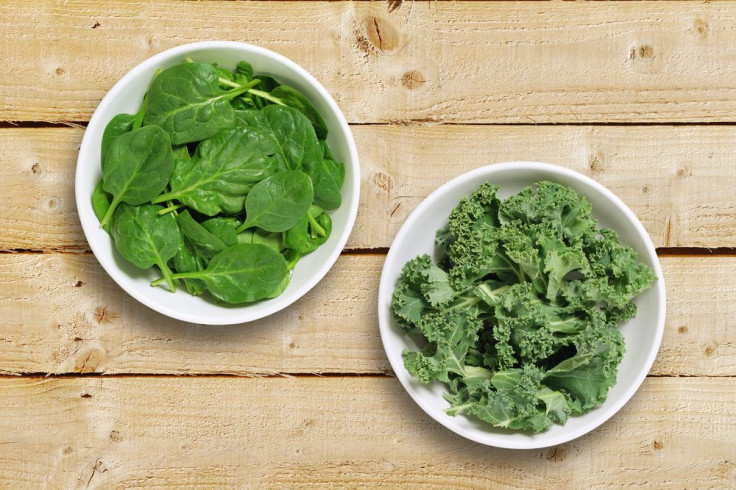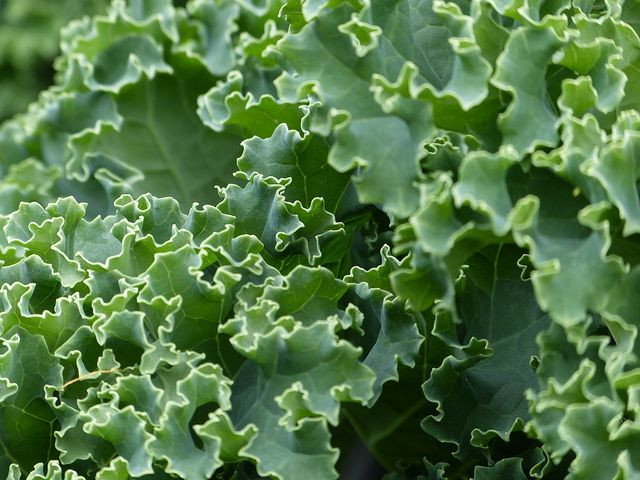Battle Of Superfoods: Which Is Better For Your Health, Kale Or Spinach?

There’s no mistaking that both kale and spinach are both extremely healthy vegetables that would make an excellent addition to any diet, but when it comes to determining which leafy green is necessarily the healthiest, things get a bit complicated.
Nutritional Value
When it comes to nutritional value, both kale and spinach have different strengths. Spinach has nearly half as many calories per serving as kale, although it’s not likely that eating either of these will result in weight gain. The higher fiber percentage in spinach makes it a good side for those who suffer from regular dietary issues, and studies have shown that risk of colorectal cancer can also be lowered by consuming high amounts of fiber, The Huffington Post reported.
Spinach is also a winner for its amount of folate, a nutrient especially important for pregnant women or women looking to become pregnant. Folic acid has been linked to lower risk of small gestational age, a term used to describe babies who are smaller than the usual amount for the number of weeks of pregnancy.
And, it looks like Popeye was right in his dietary selection. According to Prevention, spinach beats out kale in its percentage per serving size of iron and magnesium nutrients required for normal, healthy body function.

But, while spinach’s nutritional game is strong, that doesn’t mean that kale doesn’t have its own personal health advantage. Kale is slightly higher in protein and calcium — two nutrients also necessary for optimal health. However, it's kale's vitamin makeup that makes it truly remarkable. The leafy green has more than four times the amount of vitamin C as spinach and significantly more vitamin A, the nutrient necessary for eye and skin health. One serving of kale contains an impressive 907 percent of your recommended daily amount of vitamin K, a nutrient vital for bone protection and blood clotting.
For What It’s Worth
Anyone who has purchased (or grown) spinach and then cooked it for a dish knows that the plant has a truly annoying habit of shrinking. For this reason, Prevention reported that it takes 3 cups of raw spinach to make up a serving size, compared with the 1.5 cups of kale necessary to make a single serving.
Not only does kale not shrink as much when preparing, but it is also heavier and denser than spinach, meaning that you will need to eat less to feel full. With most supermarkets selling spinach at a slightly higher price per pound, it seems that kale might be the most economical choice for those looking to save a few bucks.
Any Cons?
With so much national value, it’s hard to picture any downfalls of eating either of these vegetables, but what makes these foods especially healthy can also make them especially dangerous for those with specific health issues.
Vitamin K plays an essential role in our body’s ability to clot blood. Without it, we would bleed profusely from even the slightest cuts and wounds. However, according to the National Institutes of Health, for those with health concerns that make it necessary to be on blood thinning medication, additional vitamin K can be very dangerous.

Warfarin, the main medication prescribed to those with a history of blood clotting disorders, works by specifically decreasing the amount of vitamin K in the body, thus lengthening the time it takes for a clot to form. Eating large quantities of food especially high in the vitamin can reverse this affect and put patients in danger for experiencing a life-threatening blood clot. Kale has one of the highest amounts of vitamin K per serving size available naturally, but spinach’s vitamin K levels are also impressively high.
Another notable con against kale is its association with increased risk of developing hypothyroidism, also known as an underactive thyroid. This is because kale contains a compound known as goitrin, which has been found to interfere with thyroid hormone synthesis, Common Health reported. Of course, one would have to eat kale every day in order for this to be of any concern, but cooking kale can help the goitrogenic properties of kale.
And The Winner Is…
There really is no clear winner when determining whether spinach or kale is better for you because we all have different nutritional needs. While kale is a nutritional powerhouse, making it a winner for those who are trying to eat healthy on a budget, the folic acid in spinach makes it the clear choice for pregnant women or those trying to conceive.
Otherwise, it’s best to include both of these superfoods in your diet.



























